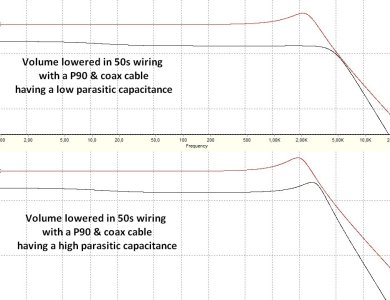gimmieinfo
Active member
The DiMarzio EJ is based on a Filter'Tron, if memory serves me. Its inductance is something like 2.3H and 1.8H (for B & N models), which is effectively on par with the inductivity of Fender single coils. T-Top's and PU's with similar specs have a beefier inductance and have been used in countless rock tracks, anyway. What they share with single coils is the pointy narrow resonance, making them tight if needed.
To illustrate my statement, I'll share below the frequency response of 2 neck HB's mounted in guitars with similar specs and played in chords direct to the board, through a 1M input.
Blue line = a modern Gibson 496R. All frequencies from the 82hz of a low E string to 800hz are promoted, sometimes of 9dB. Talk me about mud city.
Orange line = a Patent Sticker T-Top. It's tight. Even tighter than the stock neck single coil of a (real vintage) 1962 Strat that we've compared to it.
For the record, the neck PU in my LP number one has practically the same tight EQing and cleans up very well when I lower the volume. It's a P.A.F. clone built with NOS materials.
Now, such a frequency response doens't require vintage pickups nor even vintage materials : it just needs a high Q factor, that pickups like the SH2 exhibit.
BTW, higher resistance pots also make the resonant peak higher and narrower, rising artificially the Q factor.
FWIW. If higher resistance pots are effectively the solution, all my rambling above is useless anyway. ;-)
Higher resistance wasn't the solution, it was just one small improvement among many i have done and may have been the final one that took it over the fence. I will see saturday, but at the moment it's not bad at all. I just spent another bit playing it and i was really pleased with this LP for the first time. But that neck could still be a bit chimier so i will see how it fares saturday and if the neck isn't 100% there i'll look at the jazz. How would that compare to the 59 neck? They similar designs aren't they?

